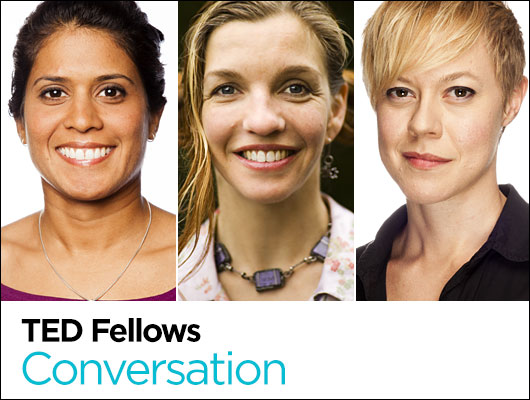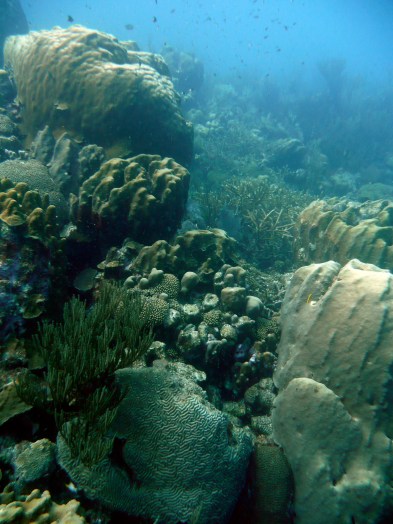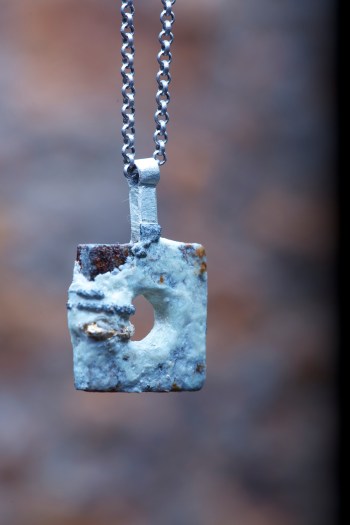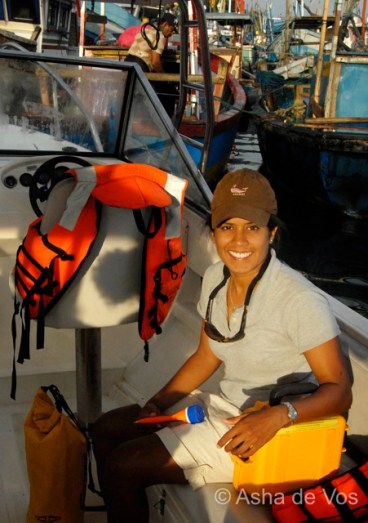
Describe what you do and what you’re working on. And where are you on the science/art continuum?
Asha de Vos: My overall aim is to reduce blue whale deaths by ship strike in Sri Lankan waters. At the moment, I’m trying to figure out how the physical environment influences the biology in the area. Why do Sri Lankan blue whales hang around permanently around our shores, around one of the busiest shipping lanes in the world? Is this area really so important that they risk everything to spend so much time there? The questions are endless.
I am very much on the science side of things, because that’s how I’m wired. However, I do think being able to cross over (or being able to identify artists who you can work with) can really make getting the message out there a whole lot easier. Scientists are so driven to publishing and conversing — it’s the way our system works. But if we want to make a difference and save ANYTHING, we need to ensure that as many people as possible know what’s going on. For this, we need to be creative. I’m not a born artist, but having been brought up in a family full of them, I have always believed in the power of art.
Colleen Flanigan: I come from the art side of the coin — but with a very curious nature. As a kid, I’d catch lizards and caterpillars, raise bunnies, mice, rats, hamsters, dogs, and I loved to observe, care for, and yes, pet them. Plus I was raised by the ocean!
I’m tactile by nature, and respond to my strong emotions and thoughts through juxtaposing objects and materials. Through making, I grow and feel the sensation of all-encompassing connection. Looking over my past artwork, I see I was taking steps towards coral restoration and wildlife conservation early on. My intuition and visions translated the subject matter of life/death into labor-intensive mixed-media works. In the installation “Conquest,” I was addressing humanity’s drive to conquer and tap natural resources. My work had real fur and animal parts, narratives about remembrance and the short-sightedness of many of us humans.
Now I am working at the intersection of sculpture and reef ecosystem rehabilitation. I create Living Sea Sculptures — undersea sculptures that aim to regenerate coral habitat using the Biorock mineral accretion technique for growing coral reefs using metal and electricity — as a hands-on method for art, science, and technology to address regions with devastated reefs and endangered corals facing heating waters and crumbling exoskeletons.
I started my Senior TED Fellowship doing a dance, science, sculpture exhibit with a modern dance company.
Lots of great concepts and useable content came out of our retreat, including three aerial steel sculptures, which I now plan to use as the basis for another piece: they’ll serve as frameworks for kinetic “skins” that reveal a correlation between human health and coral health through data sensors in the context of symbiotic artificial respiration and life support. There are many mediums in this installation. It will be my debut into e-textiles and adding multiple layers of footage. In a way, it is data visualization in three dimensions, with the participants being the drivers to activate the simulation.
Kristen Marhaver: I’m a coral reef biologist by day, and I’ve been an artist throughout my life. In my scientific work, I study how corals survive the earliest hours to months of their lives — from swimming larvae to little, squishy, milimeter-wide polyps settled on the reef that can’t move for the rest of their 50- to 500-year lives. What are coral larvae looking for and smelling when they arrive on a reef? And how can we encourage them to show up and hang out on coral reefs again?
This past year, I’ve been testing bacterial isolates one by one to identify those that change larval behavior in corals. So far I’ve found quite a few that increase the rate of settlement in a particular coral species. Success! The next steps are to test whether we can boost settlement and survivorship with these coral reef “perfumes,” to dig in deeper to find out where these bacteria are found on reefs, and to understand how the corals are actually detecting these bacteria.
The hidden artistic benefit of all of this is that I get to look at gorgeous and funny corals all day long. To me, science is a craft that rewards artistic skill — a carefully honed eye, patience, creative thinking. I love that. Artists and scientists live for the “A-ha” moments. I actually took art courses all through my PhD, even though it made me a slower scientist. The reward was that studying art also made me a better scientist, thanks to skills learned and having alternative ways to sort through ideas. Underwater photography is a great platform for carefully observing and understanding nature, but so are sculpture, painting, mixed media. And science and nature definitely come barreling through my art projects whether I want them to or not!
Colleen: That makes me think about the impulse that motivates both science and art — and I like to refer to the book Art & Physics: Parallel Visions in Space, Time & Light by Leonard Shlain to see some of the historical overlap. In the metal arts, one medium I feel very at home with, there is a lot of chemistry, math, and physics nestled unobtrusively when you are soldering, “patinaiing”, casting, annealing, electroforming, enameling. It really has science embodied in it. And one time while in school I received a small merit scholarship and some flyer quoted me: “I hope to discover a new metal surface treatment.” I totally forgot about that till cleaning out my life one day later, and realized then that my work with Biorock for corals and as a metal surface for experiments in art fit that curiosity. Wolf Hilbertz invented Biorock, but there is so much exploring to do! This year I made the first round of bit-o-Biorock pendants, and I am trying new shapes and making “a-ha” mistakes by putting “wrong” metals in. I have also been working with Biorock in a tank with living corals. This has helped me to get more intimate with the process so that I have a better understanding of how it works in the ocean too.
How do you each work with both disciplines for marine biology conservation outreach?
Asha: As far as conservation outreach goes I do public talks to anyone from age 3 upwards. I run a blog, participate in documentaries, and write articles for magazines of all kinds. I’ve also done a TED-ED, which should be out soon, and a TED-ED flip which should come out about the same time. That one was about fisheries and their unsustainability. It’s a really cool way of getting mini-stories with lots of information out there. Being paired with those awesome animators is a dream come true! All of this takes time but I believe its absolutely essential, an obligation even, for scientists to tell people what they are doing and spread the word. All of us is better than one of us, this is not just my quest – its all of ours.
Colleen: I want to “save the corals,” but obviously it’s not a lone task, and as an artist, I need to have creative ways to engage. So how to invite more people into the conversation and allow them an entry point into the action? One way is to offer a tactile experience: I’ve found that the simple experience of re-enacting Biorock restoration (on land) with steel sculptures and crocheted corals, jellies, and needle-felted fish has real impact on people when juxtaposed with video of live ocean projects and actual mineral accretion samples.
I also have a new Living Sea Sculpture blog with which I hope to bring more people into the conversation. I’d like to spend more time making habitats and protecting shores, yet as Asha says, it is crucial to give talks and communicate. The blog is intended to be a place where I talk about not only practical, realistic Living Sea Sculptures in progress, but a place where I can weave a stream of consciousness content around the topic and see if people from various locations, interests and backgrounds will begin to dialogue about corals and environmental concerns, studies, art, philosophy, and so on. I’d REALLY love if it can lead to some real-world coral refuges, since bringing teams together that are able to get those permits and build infrastructure on location is crucial to success of these projects. I imagine it can be a place for the Living Sea Sculpture diaspora to come together. I’ve also been working on a documentary with Mike Gerzevitz, a filmmaker, on a documentary about the Living Sea Sculpture project in Cancun.
I’m finding that people in both the sciences and arts want to participate. Many have come to me this year with creative ways to “message” about corals restoration, sea level rise, ocean action tracking. Julie Stein, biologist and executive director of Certified Wildlife Friendly, and her beau, Aaron Raitiere, wrote and produced a song, “Cancun Kiss,” dedicated to the Living Sea Sculpture project in Cancun. Proceeds will go towards the work. And Romain Vakilitabar, who is 20, just completed a Kickstarter campaign for his book about the cultural side of sea level rise, Matteo’s Day Off. It’s great when more people join in the most pressing stories of our contemporary planet; it shows that there’s a shift in awareness and ever-expanding active networks around the conservation issues.
Yesterday an article about coral reefs covered the work of lead scientists from Carnegie studying climatology and the all-critical carbon issue/decrease in pH. It inspired me to think more about how this exhibit might be a portal to work more closely with a university, museum, or scientist. What is the right venue for it? Since sensors and health, epidemics/pandemics, coral biology, respiration, and other scientific factors are motivating this installation work, I’m wondering who in the scientific community might want to partner and see this work completed.
Kristen, as you are studying the larval settlement, I’d love to see what you would discover with Biorock projects — if your coral larvae approach it willingly since it is made of seawater minerals, or how they feel about the low-volt current.
Kristen: I would love to know what my larvae do in proximity to Biorock surface! If Biorock increases coral settlement over ambient conditions, it is because it attracts more larvae? Or because the same number of larvae settle, but fewer die? We know that the faster they can grow early on, the better they compete and hold their ground.
In the world of conservation and outreach, I’ve dabbled in all different forms — public speaking, writing, photography, aquaristry. I love chances to show people marine creatures because — going back to what Asha said about awareness and what Colleen said about aesthetics — I think people really love to be fascinated, stunned by nature itself. No one wants to hear what percentage of the coral reef are dead. They want to learn something mind blowing, eye-opening, something that rattles around in their brain for the rest of the day. Coral larvae are pretty ideal mind-bogglers for show-and-tell purposes — little swimming blobs of fat that can see, smell, hear, and build car-sized structures of limestone if given enough time. Absurd! Sometimes I don’t even believe it. Anyway, doing good science communication, especially about conservation, requires an approach from the world of beauty, storytelling, creativity, wonder. Work like Colleen’s — making art about science and nature — is so important in this because it gives people an “in” to find their “A-ha” moment.
Not to kill the art buzz, but I’ve also been working lately on the data gathering for a big conservation project related to land rezoning. This is a “no-wonderment-allowed” operation. As much as public communication must be about beauty and wonder, boots-on-the-ground conservation is often about law, economics, policy, public health…. My professors at Scripps brilliantly made this central to their conservation teaching, even as they championed creativity and fearlessness in science communication.
But even in this world, aesthetics are helping the cause. Thanks to environmental economics, we now have ways to put dollar values on how much people value the aesthetics of environmental resources, like coral reefs. What economists call “contingent valuation” is one method they use to calculate the “existence value” of a resource — how much do we value the fact that corals reef are out there, looking awesome, staying healthy, being their amazing selves? Economists can survey, say, how much a person would pay to prevent 20% degradation to a coral reef. After adjustments for biases and tallying how many people feel the same way, they come up with a valuation of that reef. The numbers can be astounding. A study in 2011 in Hawaii of the full value of the coral reefs — from fishing, tourism, diving, and things like aesthetic value — concluded that Hawaiians value their reefs at $33 billion per year. Stunning! It may feel cold or contrived to bring money into an argument that should be about cultural and natural heritage, but the truth is there is no other way to factor “loss of the total awesomeness of these coral reefs” on the economic impact analysis for a development plan.
So as nature’s works of art, we can use the aesthetic value of ecosystems — the value we place in experiencing Mother Nature in all her glory, or even just knowing it exists — as a practical and extremely logical argument for conservation. We just have to make sure we don’t forget that such numbers are tools to estimate what is indescribably beautiful, rare, and often irreplaceable. I would hope that no one feels corals are worth protecting if they’re worth $500 a polyp but not $495.50. But if we know that the glittery, squishy, fluorescent dazzle of corals is worth a few bucks, that helps us argue on their behalf.
What are some of the challenges you face specific to where you work?
Asha: Conservation has never been very high on the agenda in Sri Lanka. We have very few marine protected areas, and none of them are well managed at all. It is really quite sad to see people walking on coral and chasing turtles. These days, things have gotten worse. Sri Lanka just came out of a three-decade war and now there is a whole lot of uncontrolled development going on. The drive is to bring in tourists (beyond carrying capacity) at any cost so hotels are being built, national parks are being rezoned to allow for development, and little thought is being given to the very resource that we depend on to bring these tourists in. Unfortunately conservation is not what brings in votes, tourism is.
Our education system makes no mention of conservation. Add to that the fact that there is immense jealousy and narrow mindedness in our field. You’d think that people who cared for the whales would want to work together to protect them. Unfortunately, that’s not how it works. Not everyone is keen to work together which means some stuff that happens is fragmented. I feel lucky though, I can hold my head high because I have been taught and am supported by some of the finest marine mammal scientists in the world. Sometimes I think they have more faith in me and my abilities than I do!
Because I’m from a country that is not dominant in my field, I was an outsider for the longest time. That meant I really had to prove myself for people to pay attention and become aware of my work. Another thing that makes life challenging is that I am female. I work in fishery harbours with fishermen. I carry heavy things, I am clearly of marriagable age but haven’t been married off. I break the stereotypes and I have to deal with many questions. But there is progress. Sri Lankans who go whale-watching have grown a conscience after watching documentaries where I discuss the problems, and are vocal about abuses. Awareness has certainly been created!
Kristen: It’s pretty stunning how self-protective the old guard in science can be. Perhaps there is even more ego in research areas with such cachet, like whales and coral reefs. No matter the struggle, I think it’s our obligation to figure out the systems we work in, make new opportunities for ourselves, and then help our junior colleagues — male and female — right along after us. It’s no good to make progress if we slam the door shut behind us!
It’s really interesting to hear about conservation in Sri Lanka — as in so many places it sounds like rampant development is once again the biggest threat to marine life. Just recently, a study came out reporting that development for economic growth has destroyed 80% of China’s coral reefs, pretty much silently. Again there is this awareness gap that has to be tackled before anything else can happen. You’ve made huge progress raising awareness of the whales in your county’s waters, and yet for all of our projects, I think we all feel we have so much distance left to cover. After my Fellows talk at TEDGlobal, quite a few people confessed that they had no idea corals were animals. I thought, okay no shame in that, but where were my scientific elders for the last 50 years? How did we fail to communicate this? I guess while countries were pushing for rapid development and economic growth, and sometimes fighting wars, scientists still thought communication and outreach were taboo, tarnishing to one’s objectivity. Surprise, that didn’t work out so well. Now our generation of scientists is playing a crazy game of communications catch-up.
Where I work on Curaçao, we just watched the pressure for coastal development ramp up FAST this past year, in the island’s most pristine areas! We are talking one of the absolute best reefs left in the Caribbean, the most intact terrestrial and marine ecosystem on Curaçao, and the only known habitat for some species. Given all of that, it qualifies for protection as a wetland of international importance under the Ramsar Convention. And Curaçao is obligated to protect it under certain parts of the Cartagena Convention. So far, the conservation of Oostpunt was mostly historical luck plus the fact that the landower defends the beaches from interlopers with a shotgun. Now Curaçao’s government can’t afford to pay the landowner compensation payments for not developing the land, so in October, the government’s Ministry of Traffic, Transportation, and Urban Planning proposed a rezoning plan that would turn this entire area into 19,000 houses, 2,400 hotel rooms, two or three marinas, three golf courses, 55km of roadways, a wind farm, agricultural areas, and all the required utilities and infrastructure. Just to settle their debt.
Culturally, it would be like paving Yosemite National Park, or turning the Sistine Chapel into a Wal-Mart. You might make the same amount of money from a Wal-Mart in place of the Sistine Chapel, but is that what you want to be known for? I guess this brings us full circle. If a culture is not willing to destroy its famous works of art for economic development, why are we so relaxed about destroying Mother Nature’s famous works of art? I mean, she worked WAY harder than we did on her installation pieces! Who do we think we are?
Colleen: There’s no real protection for famous art either. Think of all the destroyed religious architecture, icons, and art in wars, riots and looting, but in those cases, the world seems to acknowledge that something terrible has happened because art has some recognized innate value, and marine wildlife is still struggling for that. The world may soon lose these irreplaceable Buddhist icons to copper mines and economic “growth.” As Asha and you both illustrate, if war and short-term development gains are at the fore, it takes persistence and ingenuity to get marine conservation into the equation.
The conflict between old and new, protection and progress are such muddy territory. This brings me back to the issue of intimate engagement with the ocean, and the new fusions of artists and scientists in this field. The Elliott Bay Seawall Project in Seattle is currently inviting artists into the design team that will be made up of of biologists, engineers, designers, architects, builders, and government. In the call for public artists, it requested previous experience with marine science and natural history. They want the artists to help restore the marine habitat and salmon migratory route as well as create a waterfront site that attracts people. Those are projects I want to be a part of!
So do you think we are witnessing a turning point where art and science become increasingly interdependent in promoting conservation?
Colleen: We are clearly moving into the era where art consciously can move environmental health along. Art has ALWAYS subconsciously and unconsciously been a leader in forward progress and human development, yet I think the chapter of climate change and sea-level rise is going to bring more and more artists actively into the fold.
Kristen: Slowly an appreciation of the arts does seem to be sneaking into science — the “Dance Your PhD contest” sponsored by AAAS is an example. And there is a campaign now to include art training in the STEM fields (Science Technology Engineering and Math), in other words, “Teach STEAM not STEM“. They have a great headline on their website right now: “Half a mind is a terrible thing to waste!” I hope in the future we see more people approach the artist-scientist continuum as professional artists in pursuit of serious projects in biology — like Colleen. I think she has applied for more underwater permits and raised more kilograms of coral than I have!
Asha: We have the responsibility of taking people to the ocean through every means available to us. You would not believe how many Sri Lankans have written to me confessing to not knowing that we had whales in our waters. There is no shame in that at all, but playing catch-up is hard. Unfortunately, we as humans value things in weird ways. The tangible is always easier to sell than the intangible. An ancient site gets trashed, people make a fuss because it’s tangible. But the marine environment has been so far from people’s consciences for so long that the connection with it is lacking. THIS is what we have to create through our work — a connection with the marine environment so that people feel the sadness of destruction, making what we are losing real. It’s not a choice, but an obligation and responsibility.



Comments (2)
Pingback: American Steroids
Pingback: Wizmo Blog » Blog Archive » Dazzling in the deep: A Fellows Friday conversation with Asha de Vos, Kristen Marhaver and Colleen Flanigan